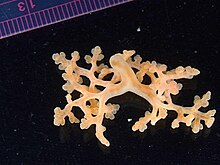| Ascothoracida | |
|---|---|

| |
| A member of the Dendrogaster genus | |
|
Scientific classification
| |
| Domain: | Eukaryota |
| Kingdom: | Animalia |
| Phylum: | Arthropoda |
| Class: | Thecostraca |
| Subclass: |
Ascothoracida Lacaze-Duthiers, 1880 [1] |
| Orders and families [2] | |
|
Dendrogastrida Grygier, 1987
Laurida Grygier, 1987
| |
Ascothoracida is a small group of parasitic marine crustaceans, comprising around 100 species and divided into Dendrogastrida and Laurida. [3] They are found throughout the world on cnidarians and echinoderms. [4] Dendrogastrida are parasites on echinoderms, and Laurida are parasites on cnidarians, except from the species Waginella Grygier, which is also a parasite on echinoderms ( crinoids). Piercing and sucking mouthparts are used for feeding, and more advanced forms also absorbs nutrients through a modified integument of the carapace. More basal forms are ectoparasitic, but most genera are meso- and endoparasitic. The sexes are separate, except from secondary hermaphroditic species of the Petrarcidae. In many species the larger female often have smaller males living inside her mantle cavity. [5] [6]
Ascothoracida was previously ranked as an order within the infraclass Cirripedia ( barnacles), but now both Ascothoracida and Cirripedia are considered separate subclasses. Those two subclasses, along with Facetotecta, make up the class Thecostraca. [2] [7] [8]
The thorax of Ascothoracida species has six pair of biramous appendages, while the abdomen has four segments and a terminal telson with a caudal furca. [9] This arrangement is similar to that seen in copepods. [9] In addition, there is a bivalved carapace, which is expanded in females. [9]
References
- ^ "Ascothoracida Lacaze-Duthiers, 1880". Integrated Taxonomic Information System. Retrieved December 8, 2010.
- ^ a b Joel W. Martin & George E. Davis (2001). An Updated Classification of the Recent Crustacea (PDF). Natural History Museum of Los Angeles County. pp. 132 pp. Archived from the original (PDF) on 2013-05-12. Retrieved 2009-12-31.
- ^ Paul Schmid-Hempel (2011). "The diversity and natural history of parasites". Evolutionary Parasitology: the Integrated Study of Infections, Immunology, Ecology, and Genetics. Oxford University Press. pp. 18–51. ISBN 978-0-19-922949-9.
- ^ J. K. Lowry (October 2, 1999). "Ascothoracida (Thecostraca, Maxillipoda)". Crustacea, the Higher Taxa: Description, Identification, and Information Retrieval. Australian Museum. Archived from the original on February 24, 2012. Retrieved December 31, 2009.
- ^ Parasitic Crustacea: State of Knowledge and Future Trends
- ^ Atlas of Crustacean Larvae
- ^ Chan, Benny K. K.; Dreyer, Niklas; Gale, Andy S.; Glenner, Henrik; et al. (2021). "The evolutionary diversity of barnacles, with an updated classification of fossil and living forms". Zoological Journal of the Linnean Society. 193 (3): 789–846. doi: 10.1093/zoolinnean/zlaa160. hdl: 11250/2990967.
- ^ "World Register of Marine Species, subclass Ascothoracida". Retrieved 2021-08-22.
- ^ a b c D. R. Khanna (2004). "Segmentation in arthropods". Biology of Arthropoda. Discovery Publishing House. pp. 316–394. ISBN 978-81-7141-897-8.
External links
-
 Data related to
Ascothoracida at Wikispecies
Data related to
Ascothoracida at Wikispecies